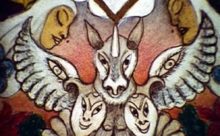Role of Religion in Outsider Art
From Roger B. Manley, The Functions of Outsider Art. M.A. Thesis (University of North Carolina, Chapel Hill, 1991), pp. 75-77.
The North Carolina painters Rev. McKendree Long, Minnie Evans, Henry “Royal King David” Davis, Jr., and Jerry Cook have drawn a reserve of energy from religion and applied it to their work with great force. Artists like Evans and Cook have dealt with their individual understandings of divine order, and their paintings emphasize the relationships between themselves and God, while artists like Long and Davis have focused on the apocalyptic end awaiting the species, preferring to deal with humanity in the mass. In both cases the work places the special inspirations of wonder, prophesy, and dream on a shared foundation with scriptural imagery.
Outside the state, Minnie Evans is perhaps the most widely recognized North Carolina outsider artist.
The primary subjects explored by Minnie Evans include images inpired by religious conviction, representations of nature, renderings of specific dreams and visions, and fanciful visions of the exotic. It is often difficult to separate these subjects from one another, for a single work by the artist often combines more than one theme. Likewise, the meaning of these various subjects is highly interrelated (Kahan 1986:15).
Evans is best known for her small symmetrical crayon drawings, which blend dense vegetation, winged angels, staring eyes, and imaginary antediluvian animals into vivid patterns of brilliant color. Since for the most part the images only hint at traditional motifs and spring out of an idiosyncratic interpretation of reality, the viewer experiences Evan’s personal religious vision as a shared mystery.
Though the work of Rev. McKendree Robbins Long relies on stylistic and symbolic themes developed by trained artists, it reflects an obsessive religious point of view no less intense than Evans’s. Long’s paintings from his Revelation series depict the stages of civilization’s collapse and redemption in the first of Armageddon, but Long’s is a civilization that combines ancient heroic drama with such features of contemporary life as jet airliners and powerboats. Like an earlier allegorist, Dante Alighieri, Long used his work as an opportunity to state political and philosophical viewpoints; in one painting Hitler, Mussolini, and Krushchev are drawn down into the pit of Hell, while Descartes, Einstein, and Darwin look on.
